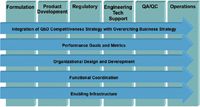Quality by Design: The Case for Change (Part II)
A rigorous cost-benefit assessment can help to chart a cost-effective path forward.
Editor's Note: Part I of this two-part series ran in the March 2011 issue of BioPharm International. That article put forth the following premises:
Organizations that recognize quality by design (QbD) as a necessary component of an integrated enterprise-wide strategy will have a distinct competitive advantage over those who do not. Competitive advantage potential is not confined to manufacturing, but rather, it permeates all critical aspects of enterprise performance from research and development (R&D) through commercialization. The broad cross-functional implications of effective integration and the downside potential of ineffective integration and functional coordination make leadership by executive management essential. Functional managers who understand the science and technical implications must be able to translate that knowledge into the language of financial, operational, marketing and strategic advantages that is the lingua franca of CFOs and other top leaders. In short, managers must be able to develop a business case. This article discusses that general business case in more detail.

James P. Catania
A business case for implementing a QbD approach essentially involves development of a cost-benefit analysis encompassing the following:
- Organizational readiness to capitalize on the emerging compliance paradigm
- Clearly defining how QbD reduces risk and cost for the enterprise (i.e., product pipeline versus the organization's historical cost and speed profile).
Beyond the general business case lie the challenges of engaging the larger organization in undertaking and developing the specific business case for the company's particular situation and embarking on a QbD initiative. Those challenges include:
- Enrolling management in a more rigorous assessment of costs and benefits
- Developing a phased, integrated path to organizational competence
- Recognizing and achieving new paradigms in cross-functional coordination.
By making the general business case for QbD and mobilizing executive management to undertake its careful consideration, you can not only help demonstrate to management the way to untapped business value but also greatly increase the scientific rigor and competence of the organization's technical functions.
ELEMENTS OF A QBD COST-BENEFIT ASSESSMENT
For the purposes of this article, we are defining QbD as the submission to FDA of a design-space based validation as opposed to a traditional three-batch validation. The assessment that follows, therefore, involves gauging the current state of the organization in terms of potential financial benefits of implementing QbD and the potential costs to realize those benefits.
The objective is to achieve a strategic competitive advantage in the marketplace. Defining and implementing such a strategy will require leadership from the highest levels of the organization. Any assessment must, therefore, rigorously address the fundamental concerns of top management across all functional silos.
There are many who would argue that the strategic benefits of QbD are self-evident and, given the trend in industry and FDA's endorsement to support the approach, organizations ought to make the transition as quickly as possible. Be that as it may, it is still incumbent upon management to determine the cost and benefit of such a transition if for no other reason than financial planning.
The following section outlines some major factors to consider when estimating potential costs, benefits, and return on investment (ROI) with a QbD approach. Given the potential change-management issues that may arise during assessment, it is recommended that a cross-functional governance structure involving upper levels of management be put in place to direct the effort.
ASSESSING POTENTIAL FINANCIAL BENEFITS
Too often QbD benefits are described in broad, idealized, hypothetical terms. This is exactly what we don't want to do if we are committed to rigorously addressing the fundamental concerns of top management and enrolling them in leading a transformation. Specifically, both the potential financial benefits and the potential costs to position the organization to effectively execute against a QbD strategy need to have sufficient rigor to obtain the buy-in of the finance team. Regardless of perceived benefit from the technical wing of your organization, if the CFO isn't on board, any effective integration of QbD into the organization's overall strategy and its associated organizational transformation impact is jeopardized before it begins.
A credible current-state analysis to identify and quantify potential financial benefits needs to involve an analysis of the organization's historical performance vis-à-vis the management of risk and life-cycle costing. A candid, forensic assessment tracing current products through research and development (R&D), scale-up, technology transfer, and commercial production will identify cases in which unexpected delays and costs were incurred which could have been avoided if the organization had been employing a QbD strategy.
Essentially, this is an estimate of the cost of poor quality (COPQ) associated with the organization's historical pattern of deviations and corrective actions but, unlike traditional COPQ assessments, the scope of the analysis is expanded beyond post-commercialization issues in production to include costs associated with regulatory filings, process development, and technology transfer early in the process of product development.
Products currently in development or undergoing technology transfer provide good examples for examination because these types of changes and actions are fresh in the minds of those involved.
The forensic assessment described herein need not capture every event in every product's life cycle to provide a credible estimate of opportunity. A few examples in which cost can be reasonably estimated can be more effective than many loosely quantified anecdotes.
Failure Modes and Effects Analysis (FMEA), in combination with COPQ, can be particularly helpful as well to extrapolate and estimate potential risks and associated recovery costs which could reasonably be avoided if the organization were to integrate QbD into its overarching competitiveness strategy.
FMEA is applied prospectively to an organization's product pipeline and late-stage development activities and considers the expected complexity of formulas/processes and projected regulatory filing requirements. Historical performance patterns established in the COPQ phase of the assessment inform the probability, detectability, and impact of failure in this FMEA exercise.
ASSESSING POTENTIAL COSTS ASSOCIATED WITH IMPLEMENTATION
Running parallel with the benefits assessment is the assessment of potential cost in the cost-benefits analysis. The same issues apply relative to building a credible estimate to enlist top management, particularly finance, in the opportunity QbD presents.
The assessment of cost is more challenging to nail down than the estimate of benefits, however. When assessing benefits, a company has the advantage of historical perspective of costs incurred due to delays and product losses in areas with well documented budgets.
In assessing implementation costs, one needs to estimate the cost of transitioning the organization from its current level of technical and organizational readiness to that which will be necessary to effectively execute a QbD strategy.
The FMEA developed in the benefits assessment can be useful in assessing potential costs as well. Identifying mitigation strategies to address potential failure modes and risks identified in the FMEA will, in turn, highlight gaps in organizational readiness and design for which corrective action costs can be estimated.
Figure 1 illustrates the major considerations in functional coordination associated with mitigating risk and executing a transition to a QbD strategy. Each organization will be at different places on the continuum of readiness to implement these elements and each has its own associated costs.

Figure 1: Cross-functional coordination involves support across all divisions.
Considerations include not just the gap in technical know-how, but also issues related to change-management and the speed with which the organization can make the transition. Organizational transformation to adopt QbD will probably involve changes in organizational design and in cross-functional interactions. Such changes can encounter strong resistance by those attached to the status quo.
Temporary outside assistance to smooth these issues and facilitate change may help accelerate transformation and reduce cost. Particularly complex products or processes may require extensive experimentation and more time in development to adequately characterize the process and present acceptable data. Inexperience both internally and within FDA may cause delays in first-time QbD-based submissions, a potential cost that should not be overlooked.
Finally, upgrades of software and data-management systems may be required to allow integration of historical data and to facilitate cross-functional coordination. These potential costs need to be considered as well.
In the weighing of costs and benefits, it has been our experience in working with many life sciences companies that the organization-specific benefits of QbD almost always far outweigh the costs, yielding an ROI that continues to grow year after year.
However, the great magnitude of the potential benefits does not mean that the organization should immediately undergo massive transformation, a giant step that many leaders and decision-makers may be unwilling to take up front. Instead, one can adopt a phased approach that allows the company to move confidently toward a fully integrated QbD strategy.
Organizations can begin by building technical competence in basic process characterization, designed experiments, and hypothesis testing ahead of full scale QbD-submission preparation. Once those methods and techniques have been mastered, the organization can undertake QbD process development but also can continue to file with FDA in the traditional way. In the final phase of development, a company can embark on QbD-based filing.
It is important to understand, however, that there is a balance which needs to be achieved. Yes, there are costs and risks associated with organizational transformation but the full benefits of QbD will not be realized until the final phase, in which filings are fully QbD-based. Organizations that evolve slowly will reap some benefits along the way but will remain at a competitive disadvantage to those with a more aggressive transition strategy.
James P. Catania is a managing consultant at Tunnell Consulting, catania@tunnellconsulting.com, 610.337.0820.

VERAXA and Voyager to Create Combined Business for Advancing Pipeline of Next-Gen Cancer Therapies
April 23rd 2025The proposed business combination would create a publicly traded, clinical-stage biopharmaceutical company that will focus on developing a pipeline of next-generation cancer therapies.
Tokyo University of Science Research Team Explores Improved Delivery of Antisense Oligonucleotides
April 18th 2025Using cholesterol-modified oligonucleotides, the research team aims to improve the delivery of antisense nucleotide-based therapies for treating neurodegenerative diseases and brain cancers.
Thermo Fisher Opens Advanced Therapies Collaboration Center in California
April 18th 2025The 6000-square-foot facility will provide cell therapy developers the support they need to transition to CGMP manufacturing, and an expanded footprint of the new center is expected to open in Philadelphia later in 2025.